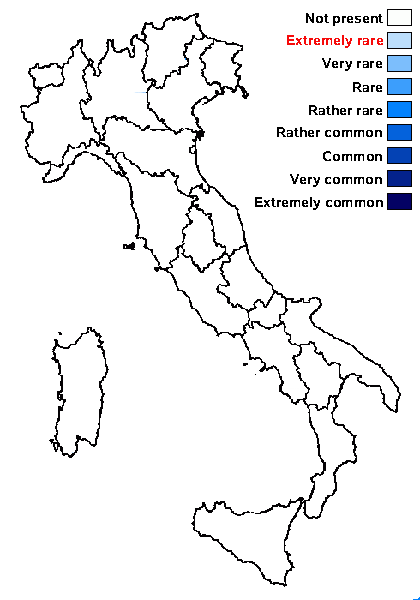Candelariella granuliformis M. Westb.
in Westberg & al., Bryologist, 114, 2: 328, 2011.
Synonyms:
Distribution:
Description: Thallus crustose, episubstratic, of rounded, scattered to crowded, 0.1-0.2 mm wide, golden yellow granules which disintegrate into 35-70(-80) μm wide blastidia. Apothecia rare, lecanorine, yellow, 0.2-0.5(-0.7) mm across, with a flat to convex disc and a thin, entire to granular, sometimes finally excluded thalline margin; proper margin sometimes visible as a thin parathecial ring. Thalline exciple with a 7-25 μm thick pseudocortex of more or less isodiametrical cells; proper exciple of branched and anastomosing, thick-walled hyphae, radiating towards the upper surface and forming a stipe below the hymenium; epithecium yellow to golden brown, granular; hymenium colourless, 90-115 μm high, I+ blue; paraphyses simple or sparingly forked in upper part, 1.5-2 μm thick at mid-level, the apical cells up to 5 μm wide; hypothecium colourless, with oil droplets. Asci 16-20-spored, clavate, with an apical dome which is I+ blue only in the internal, lower part, interrupted in the centre by a I+ paler blue strip, Candelaria-type. Ascospores 1-celled to rarely 1-septate, hyaline, ellipsoid to narrowly ellipsoid, 8.5-14 x 3-6 μm. Photobiont chlorococcoid. Spot tests: thallus K- or K+ weakly orange-red, C+ weakly orange, KC-, P-, UV-. Chemistry: pulvinic acid derivatives.Note: a recently-described terricolous species present in the Alps, but not yet reported from Italy; to be looked for, especially in the Alps.
Growth form: Crustose
Substrata: soil, terricolous mosses, and plant debris
Photobiont: green algae other than Trentepohlia
Reproductive strategy: mainly asexual, by soredia, or soredia-like structures (e.g. blastidia)

Predictive model
Growth form: Crustose
Substrata: soil, terricolous mosses, and plant debris
Photobiont: green algae other than Trentepohlia
Reproductive strategy: mainly asexual, by soredia, or soredia-like structures (e.g. blastidia)

Predictive model
 Index Fungorum
Index Fungorum
 GBIF
GBIF


